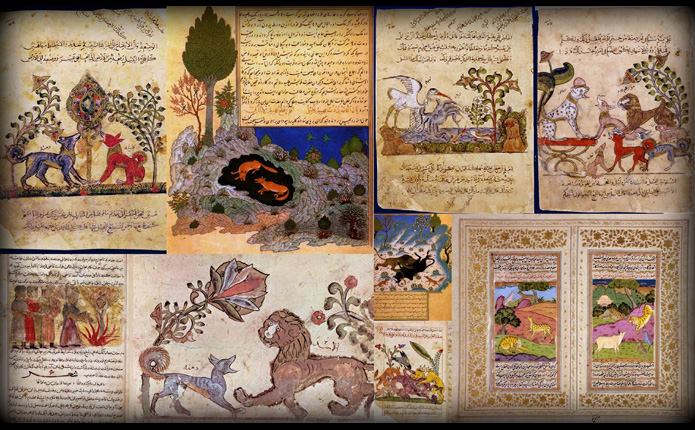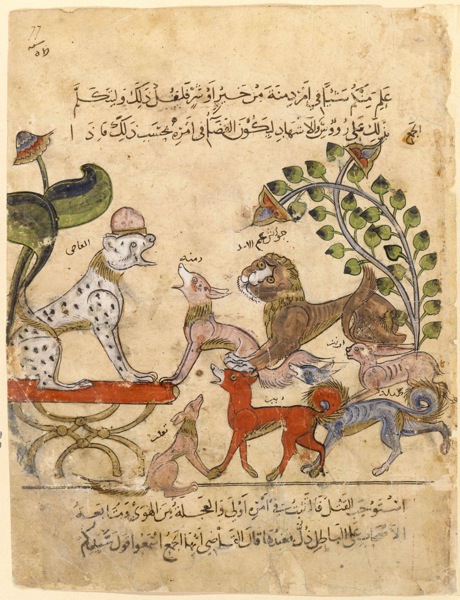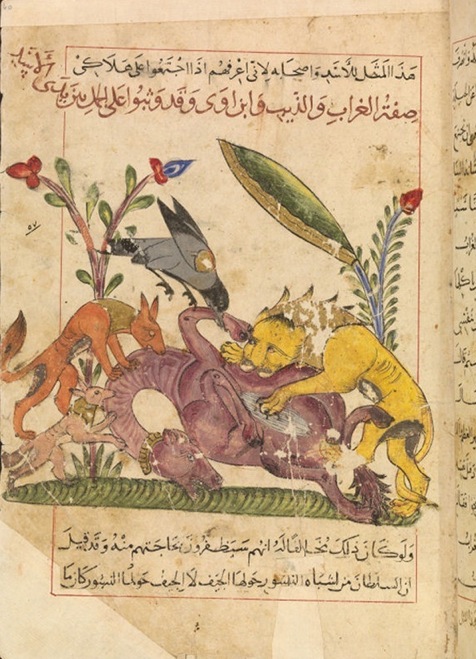

Kalila wa-Dimna
by Paul LundePublished on: 30th January 2011
One of the most popular books ever written is the book the Arabs know as Kalila wa-Dimna, a bestseller for almost two thousand years, and a book still read with pleasure all over the world. It has been translated at least 200 times into 50 different languages. In this article, Paul Lunde biefly presents Kalila wa-Dimna origins and characterizes its content.

Paul Lunde *
Note of the editor
This article was published first in the print edition of Saudi Aramco World, vol. 23, N° 4, July/August 1972, pp. 18-21 (read online here). We republish it with new illustrations and further readings.
* * *
One of the most popular books ever written is the book the Arabs know as Kalila wa Dimna, a bestseller for almost two thousand years, and a book still read with pleasure all over the Arab world.
Kalila and Dimna was originally written in Sanskrit, probably in Kashmir, some time in the fourth century CE. In Sanskrit it was called the Panchatantra, or “Five Discourses.” It was written for three young princes who had driven their tutors to despair and their father to distraction. Afraid to entrust his kingdom to sons unable to master the most elementary lessons, the king turned over the problem to his wise wazir, and the wazir wrote the Panchatantra, which concealed great practical wisdom in the easily digestible form of animal fables. Six months later the princes were on the road to wisdom and later ruled judiciously. Two hundred years after that, a Persian shah sent his personal physician, Burzoe, to India to find a certain herb rumored to bestow eternal life upon him who partook of it. Burzoe returned with a copy of the Panchatantra instead, which he claimed was just as good as the miraculous herb, for it would bestow great wisdom on the reader. The shah had Burzoe translate it into Pehlavi, a form of Old Persian, and liked it so much that he enshrined the translation in a special room of his palace.
Three hundred years later, after the Muslim conquest of Persia and the Near East, a Persian convert to Islam named Ibn al-Mukaffa’ chanced upon Burzoe’s Pehlavi version and translated it into Arabic in a style so lucid it is still considered a model of Arabic prose. Called Kalila and Dimna, after the two jackals who are the main characters, the book was written mainly for the instruction of civil servants. It was so entertaining, however, that it proved popular with all classes, entered the folklore of the Muslim world, and was carried by the Arabs to Spain. There it was translated into Old Spanish in the 13th century. In Italy it was one of the first books to appear after the invention of printing.

Figure 2: Illustration of the Crab in Kalila wa-Dimna. Syrian manuscript. Bibliothèque nationale de France in Paris, MS arabe 3465, folio 57. (Source).
Later it was also translated into Greek and then that version into Latin, Old Church Slavic, German and other languages. The Arabic version was translated into Ethiopic, Syriac, Persian, Turkish, Malay, Javanese, Laotian and Siamese. In the 19th century it was translated into Hindustani, thus completing the circle begun 1,700 years before in Kashmir.
Not all versions were simple translations. The book was expanded, abridged, versified, disfigured and enhanced by a seemingly endless series of translators—to which I now add one more: me. The story I have selected is not included in the original Sanskrit version, nor in most Arabic manuscripts of Ibn al-Mukaffa’, but it is of interest because it has entered European folklore as the story known as “Belling the Cats,” which can be found in the Brothers Grimm and many other places. The difference is that the Arab mice solve their problem much more subtly than their western cousins…

Figure 3: The trial of Dimna in Kalila wa-Dimna. Manuscript at the Bibliothèque nationale de France in Paris, Département des manuscrits orientaux. (Source).
‘There was once in the land of the Brahmins a swamp called Dawran that extended in all directions for a distance of a thousand parsangs. In the middle of the swamp was a city called Aydazinun. The city enjoyed many natural advantages and its people were prosperous and could afford to enjoy themselves however they liked. Now there was a mouse in that city called Mahraz, and he ruled over all the other mice in the city and in the surrounding countryside. He had three wazirs to advise him in his affairs.
One day all the wazirs were gathered in the presence of the king of the mice discussing various things, when the king said: “Do you think it is possible for us to free ourselves of the hereditary terror which we and our fathers before us have always felt for cats? Although we have many comforts and good things in our lives, our fear of the cats has taken the savor out of everything. I wish all three of you would give me the benefit of your advice about how to solve this problem. What do you think we ought to do?” “My advice,” said the first wazir, “is to collect as many bells as you can, and hang a bell around the neck of every cat so that we can hear them coming and have time to hide in our holes.”


Figure 4a-b: Two pages from Kalila wa-Dimna in a dispersed manuscript preserved in Brooklyn Museum (accession number 71.48) dated between 1300 and 1350, ink and opaque watercolor on paper. (Source 1 – Source 2).
Then the king turned to the second wazir and said, “What do you think about your colleague’s advice?”
“I think it’s lousy,” answered the second wazir. “After we collect all the bells, who do you think is going to dare hang one around the neck even of the smallest kitten, much less approach a veteran tomcat? In my opinion, we should emigrate from the city and dwell in the country for a year until the people of the city think that they can dispense with the cats who are eating them out of house and home. Then they’ll kick them out, or kill them, and the ones that escape will scatter in all directions into the country and become wild and no longer suitable for house cats. Then we can safely return to the city and live forever without worrying about cats.”
Then the king turned to the third and wisest wazir. “What do you think about that idea?”

Figure 5: Illustration from a Kalila wa-Dimna, manuscript dated 1200–1220 CE. This book of animal fables with a moral and a political message became, and still is, immensely popular, and was a landmark in the development of Arabic literary prose in the Golden Age of Islam. (Source).
“It’s pretty poor,” replied the third wazir. “If we leave the city and go live in the country, how do we know that the cats will disappear in a single year? And what about the difficulties we will experience? The wilderness is full of wild animals that like to eat mice, and they will do us a lot more harm than do the cats.”
“You’re right about that,” said the king. “So what do you think we should do?”
“I can think of only one possible plan. The king should summon all the mice in the city and in the suburbs and order them to construct a tunnel in the house of the richest man in the city, and to store up enough food for ten days. Have them make doors in the tunnel that lead to every room in the house. Then we will all get inside the tunnel, but we will not touch any of the man’s food. Instead, we will concentrate on damaging his clothes, beds, and carpets. When he sees the damage, he will say to himself, ‘Obviously one cat can’t handle all the mice around here! And he will go get another cat. When he has done that, we will increase the amount of damage that we do, really tearing his clothes to pieces. Again he will decide to get another cat. And then we will increase the damage threefold. That should make him stop and think. He’ll say to himself: “The damage was much less when I only had one cat. The more cats I get, the more mice there seem to he.’



Figure 6a-c: Three illustrations from the tradition of Kalila wa-Dimna in manuscripts deposited in the Bodleian Library in London: a. Ibn al-Muqaffa‘s Kalila wa-Dimna in an Arabic manuscript dated 1354 CE; b. Jacob ben Eleazar’s Hebrew translation from the Arabic, with a drawing of a jackal (15th century); c. Directorium humanae vitae: Johannes of Capua’s Latin translation from the Hebrew version of Kalila wa-Dimna (Strasbourg, ca 1489). (Source).
So then he will try an experiment. He will get rid of one of the cats. Immediately, we will lessen the amount of damage that we do by a third. ‘That’s strange,’ the man will say. And he will get rid of another cat. And we will again decrease the amount of damage by a third. Then the light will dawn on him. When he gets rid of the third cat, we will stop our destruction completely. Then the man will think that he has made a great discovery. He’ll say: ‘It’s not the mice that damage food and clothes, but cats.’ He will run to tell his neighbors, and because he is a rich and respected man in the town, they will all believe him and throw their cats out of doors, or kill them, and forever after, whenever they see a cat, they will chase it and kill it.”


Figure 7a-b: Two Illustrations from Kalila wa-Dimna, MS Revan 1022, Herat, 1430: a. Kalila visits the captive Dimna (folio 56a); b. Lion attacking a Bull (folio 46b). Source).
So the king followed the advice of the third wazir and before very long not a cat remained in the city. The people remained so convinced that they were right about the cats that whenever they saw a hole in their clothes, they would say, ‘‘A cat must have gotten into the house last night.” And even when there was an outbreak of disease among men or livestock, they would say, “A cat must have walked through the town last night.” So by this strategem, the mice freed themselves forevermore from their hereditary fear of cats.’

Figure 8: Frontispice of the Latin translation of Kalila wa-Dimna by Sebastian Gottfried Starcke: Specimen sapientiæ Indorum veterum. : Id est, liber ethico-politicus pervetustus, dictus Arabice, Kalilah wa-Dimnah Græce Stephanites kai Ichnelates, nunc primum Græce ex MSS. Cod. Holsteiniano prodit, cum versione nova Latina. Berolini : Ru¨diger, 1697. Read online here.
Resources and further readings
Editions And Translations
- Thomas North, The morall philosophie of Doni
drawne out of the auncient writers. A worke first compiled in the Indian tongue, and afterwardes reduced into diuers other languages: and now lastly englished out of Italian by Thomas North, brother to the right Honorable Sir Roger North Knight, Lorde North of Kyrtheling. Published by Henry Denham in London, 1570. - N. M. Penzer 1924, The ocean of story, being C.H. Tawney’s translation of Somadeva’s Katha sarit sagara or Ocean of streams of story: Volume V of X, Appendix I: pp. 207–242: Burzoy’s Voyage to India and the Origin of the Book of Kalilah wa Dimnah, Google Books, François de Blois, Royal Asiatic Society, London, 1990.
- Pavel Basharin, On Kalila wa Dimna and Persian National Fairy Tales, Transoxiana.com, Moscow, Tansoxiana 12, 2007.
- E. L. Ranelagh, The Past We Share. The Near Eastern Ancestry of Western Folk Literature, Quartet Books, Horizon Press, New York, 1979.
- Tahir Shah, In Arabian Nights. A search of Morocco through its stories and storytellers, Doubleday, New York, 2008.
- Abdallah Ibn al-Muqaffa, Kalilah et Dimnah. Edited by P. Louis Cheiko. Beirut: Imprimerie Catholique, 1947, 3rd edition.
- Ibn al-Muqaffa, Abd’allah. Calila e Dimna. Eds. Juan Manuel Cacho Blecua and María Jesus Lacarra. Madrid: Editorial Castalia, 1984.
- Keller, John Esten, and Robert White Linker. El libro de Calila e Digna. Madrid Consejo Superior de Investigaciones Cientificas, 1967.
- Latham, J.D. “Ibn al-Muqaffa’ and Early ‘Abbasid Prose.” In Abbasid Belles-Lettres. Eds. Julia Ashtiany, et al. Cambridge: Cambridge University Press, 1989, pp. 48-77.
- Parker, Margaret. The Didactic Structure and Content of El libro de Calila e Digna. Miami, FL: Ediciones Universal, 1978.
- Penzol, Pedro. Las traducciones del “Calila e Dimna”. Madrid,: Impr. de Ramona Velasco, viuda de P. Perez, 1931.
- Shaw, Sandra. The Jatakas – Birth Stories of the Bodhisatta, Penguin Classics, Penguin Books India, New Delhi, 2006.
- Wacks, David A. “The Performativity of Ibn al-Muqaffa’s Kalîla wa-Dimna and Al-Maqamat al-Luzumiyya of al-Saraqusti.” Journal of Arabic Literature, vol. 34.1-2 2003: 178-89.
Videos
- Manuscript of Kalila wa-Dimmna by Abdullah Ibn al-Muqqaffa’, Studied and written by Dr. Yahiya Ibn Junaid.
- Manuscript of King Faysal of Kalila wa-Dimna.
Studies and analyses
- Anvar-i Suhayli, Iyar-i Danish and Humayun Nameh. Bombay: Marg Publications, 1991.
- Atil, Esin, Kalila wa Dimna: Fables from a Fourteenth Century Arabic Manuscript. Washington. DC: Smithsonian Institution Press, 1981.
- Brockelmann, C., “Kalila wa Dimna”. In Encyclopedia of Islam, New Edition, Leiden: E.J. Brill, vol. 4, pp. 503-6.
- De Blois, Francois, Burzoy’s Voyage to India and the Origin of the Book of Kalilah wa Dimnah. London: Royal Asiatic Society, 1990.
- Grube, Ernst J. (editor), A Mirror for Princes from India. Illustrated Versions of the Kalilah wa Dimnah, Anvar-i Suhayli, Iyar-i Danish and Humayun Nameh. Bombay, 1991.
- Munther Younes, Tales from Kalila Wa Dimna: For Students of Arabic. (Paperback). Spoken Language Services; Pap/Com edition, 2001.
- O’Kane, Bernard, Early Perisan Painting: Kalila wa Dimna Manusciprts of the Late Fourteenth Century. London and New York, I.B. Tauris, 2003.
- Raby, Julian, “The Earliest Illustrations to Kalila wa Dimna.” In A Mirror for Princes from India, edited by d. Ernst J. Grube, Bombay, 1991, pp. 16-31.
- Walzer, Sofie, “An Illustrated Leaf from a Lost Mamluk Kalilah wa Dimnah Manuscript.” Ars Orientalis, vol. 2 (1957): pp. 503-5.
* Paul Lunde grew up in Saudi Arabia, studied Arabic at the University of London, and is now studying and free-lancing in Italy.























No hay comentarios:
Publicar un comentario